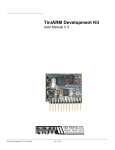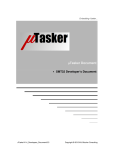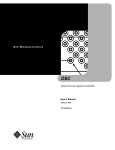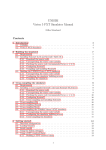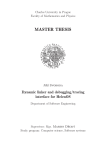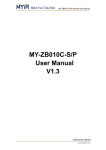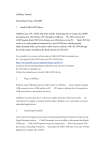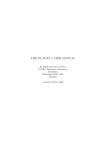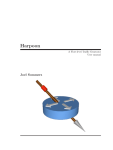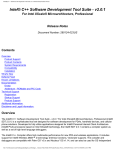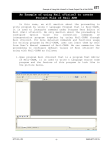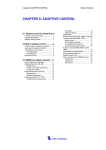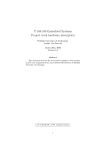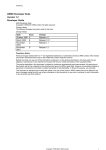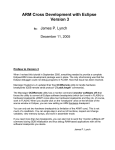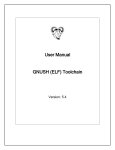Download TiniARM Development Kit
Transcript
TiniARM Development Kit
User Manual V.2
TiniARM Development Kit: User Manual
Nov 1, 2004
Table of Contents
1.0 Introduction . . . . . . . . . . . . . . . . . . . . . . . . . . . . . . . . . . . . . . . . . . . . . . . . . . . . . . .
1.1 Overview . . . . . . . . . . . . . . . . . . . . . . . . . . . . . . . . . . . . . . . . . . . . . . . . . . . . . . . .
1.2 Get (with) the Program(s) . . . . . . . . . . . . . . . . . . . . . . . . . . . . . . . . . . . . . . . . . . .
1.3 LPC2000 Flash Utility Notes . . . . . . . . . . . . . . . . . . . . . . . . . . . . . . . . . . . . . . . . .
1.4 Installing gnude on W2K . . . . . . . . . . . . . . . . . . . . . . . . . . . . . . . . . . . . . . . . . . . .
1.5 Included Files . . . . . . . . . . . . . . . . . . . . . . . . . . . . . . . . . . . . . . . . . . . . . . . . . . . .
2
2
2
3
3
3
2.0 Compiling . . . . . . . . . . . . . . . . . . . . . . . . . . . . . . . . . . . . . . . . . . . . . . . . . . . . . . . . . 3
2.1 Makefile . . . . . . . . . . . . . . . . . . . . . . . . . . . . . . . . . . . . . . . . . . . . . . . . . . . . . . . . 4
2.2 simple.cmd . . . . . . . . . . . . . . . . . . . . . . . . . . . . . . . . . . . . . . . . . . . . . . . . . . . . . . 5
2.3 main.c . . . . . . . . . . . . . . . . . . . . . . . . . . . . . . . . . . . . . . . . . . . . . . . . . . . . . . . . . . 5
2.4 ivt.s . . . . . . . . . . . . . . . . . . . . . . . . . . . . . . . . . . . . . . . . . . . . . . . . . . . . . . . . . . . . 8
2.5 start.s . . . . . . . . . . . . . . . . . . . . . . . . . . . . . . . . . . . . . . . . . . . . . . . . . . . . . . . . . . 10
3.0 Downloading . . . . . . . . . . . . . . . . . . . . . . . . . . . . . . . . . . . . . . . . . . . . . . . . . . . . . . . 10
4.0 Testing. . . . . . . . . . . . . . . . . . . . . . . . . . . . . . . . . . . . . . . . . . . . . . . . . . . . . . . . . . . . 11
5.0 Final Result . . . . . . . . . . . . . . . . . . . . . . . . . . . . . . . . . . . . . . . . . . . . . . . . . . . . . . . . 11
6.0 Helps . . . . . . . . . . . . . . . . . . . . . . . . . . . . . . . . . . . . . . . . . . . . . . . . . . . . . . . . . . . . .
6.1 Compiler: arm-elf-gcc --help . . . . . . . . . . . . . . . . . . . . . . . . . . . . . . . . . . . . . . . . .
6.1.1 Compiler Target: arm-elf-gcc --target-help . . . . . . . . . . . . . . . . . . . . . . . . . . . . . . . .
6.2 Assembler: arm-elf-as --help . . . . . . . . . . . . . . . . . . . . . . . . . . . . . . . . . . . . . . . .
6.3 Loader: arm-elf-ld --help . . . . . . . . . . . . . . . . . . . . . . . . . . . . . . . . . . . . . . . . . . . .
6.4 Translation: arm-elf-objcopy --help . . . . . . . . . . . . . . . . . . . . . . . . . . . . . . . . . . . .
TiniARM Development Kit: User Manual
Nov 1, 2004
11
11
12
13
14
17
1
Compiling an Application for the TiniARM From Scratch
Programming the Arm processor in C can be done for free with the use of the freely available and multi-optioned GNU compilers. It can
be a little daunting with 70MB downloads and thousands of pages of text to wade through to find the essential ingredients to make the
recipe you're trying to implement. This manual assumes a neophyte level user and walks through the paces to get a bare application
running on the TiniARM. With the knowledge of this journey, it is hoped that you will be able to forge your own.
NOTE: Changes from previous manual (V.1) are marked with a change bar like the one on the left.
1.0 Introduction
The first job is to get programs and documentation. Some comes with the software but sometimes they need documentation. Don't get
me wrong, it's great that there is a lot of documentation but it is vast and too many variables lie in the way of getting what I want. Where's
my hello world program with an interrupt for only 234 bytes? Not 42K of behemoth layers of OS parts and services (which have their own
empire of documentation). I often have to dig for a nugget of info to let me know which variable to modify each time something goes
wrong in compiling, but to find that nugget again would be almost impossible. So here are the steps and nuggets (most of them) I took to
get to the finish line.
To work with the target board you will need:
•
•
•
•
•
•
•
•
•
the target board
the development board
power supply
rs232 cable
PC with COM port
compiler
downloader
terminal program
patience, luck and the NMI help forum
1.1 Overview
First, edit your source code; compile it with a compiler; link it and write it out with a loader; possibly translate the output to one
suitable for downloading; download the result to the target board; attach test equipment and reset board to test it out.
Note all the steps and also note that this is a command line affair, no GUI. Although some are available, I have none to recommend
yet. So crack the knuckles, rub the palms rapidly and push up the sleeves. In addition to being command line user interface (CLUI),
it is Unixish and needs a Unix-like environment to run in. This means using the terminal window in Mac OSX and an extra download
in Windows.
1.2 Get (with) the Program(s)
Whether you are running MacOSX, Windows or Linux, there's a precompiled application out there waiting to be downloaded. These
are big and always come with many more things that you and all of your related family would never be able to use, so be prepared for
a long download even on high speed connections. This document is tied to the gnude 1.2/1.1 release on Windows 2000 and
MacOSX. Search for gnude download or if this link is valid:
http://sourceforge.net/projects/gnude/
Page down and download the appropriate version for your platform(s).
In addition, for the Windows platform you will also need to download from redhat:
http://www.redhat.com/download/cygwin.html
To communicate with the board you will need to run another program on the PC available from Philips at:
http://www.semiconductors.philips.com/files/products/standard/microcontrollers/utilities/
lpc2000_flash_utility.zip
Download what you need and install (cygwin first on Windows).
TiniARM Development Kit: User Manual
Nov 1, 2004
2
1.3 LPC2000 Flash Utility Notes
This tool is used to interact with the TiniARM processor over the serial port to move data between it, RAM, flash and the host
computer. It is mainly used to program the processor. The following points will save some time working with this tool.
• The utility for communicating with the processor for transferring data to and from the chip cannot be used to create a file which
is downloadable back to the chip because the first 0x3F bytes are not from the program in the rest of flash but are from the flash
bootloader and when the contents of flash is transferred to the program buffer, it takes the first 0x3F bytes from the bootloader
program and the rest of flash from whatever program is there. If this hex file is then put back into flash, the chip will not boot. To
fix it, the first 0x3F bytes must come from a file source which has the values figured. Or the bytes can be edited in the buffer.
The vector block has been shifted to 0x1E000 but the program prevents the user from seeing that part of flash.
• This has been fixed as of version V2.2.0 and is available from the LPC2000 files section in Yahoo groups:
http://groups.yahoo.com/group/lpc2000/files/
• There is a button to calculate the security code at 0x14 but it is on the flash buffer tool and is not needed for normal downloads.
• The tool cannot handle files which are both RAM and Flash. You will get messages complaining about memory out of range.
This could be something destined for RAM space like an initialized variable and could warrant a second look or it might not
bother you at all.
1.4 Installing gnude on W2K
Download and install cygwin to create a unix environment under windows. Put gnude under “/cygwin”. This is seen as just “/”
inside a cygwin shell. To set the PATH variable:
export PATH=$PATH:/gnude/bin:/gnude/arm-elf/bin
This will give you access to the tools with or without their prefixes. This means if there is no other gcc tools installed in your paths,
then gcc will be the same as arm-elf-gcc and can be used as a shortcut.
1.5 Included Files
•
•
•
•
•
•
•
•
•
•
•
•
•
•
•
a.lst - assembly listing of example
ivt.o - object file from compiling ivt.s
ivt.s - source code containin the exception vectors for the beginning of flash
libc.a - C library precompiled archive for use if needed
lpc210x.h - header file with names for all the registers
main.c - test program in C
main.cmd - extra complicated loader script adapted from the tools
main.hex - final output from compilation process
main.map - map of symbols and memory
main.o - compiled object from main.c
main.out - the output from the loader/linker
makefile - the script on how to make the test application
simple.cmd - the script for where the test application fits in memory
start.o - compiled object file for start.s
start.s - start up code to set up the micro and transition into main in
2.0 Compiling
All the pieces for compiling in this example reside in one directory. This makes compiling simple. Just enter this command in the
directory with everything in it:
make test
Like magic all the (and only the) required steps are executed to get from multiple source files and libraries to a singular hex file ready for
download along with a memory map file and an assembled code listing. For the first run you should see something like this:
arm-elf-as
arm-elf-as
-o start.o start.s
-o ivt.o ivt.s
TiniARM Development Kit: User Manual
Nov 1, 2004
3
.compiling
..linking
arm-elf-ld -v -Map main.map -nostartfiles -T simple.cmd -o main.out
GNU ld version 2.14 20030612
...copying
arm-elf-objcopy -O ihex main.out main.hex
start.o ivt.o main.o libc.a
As projects go, they are seldom simple, once underway for any length of time, so it is best to have some organization up front in terms of
structure. This is where the makefile and loader script come in. The makefile provides a singular point of controlling the compiling
process and a way of managing compiler options and file groupings. The loader script is the recipe for all the ingredients from the
compiler output and other precompiled archives (.a). The two files for these included here are simple and will need to be augmented as
an application grows. Probably the next best thing to add to the makefile is some semblence of proper directory structure where source
is kept separate from all the other pieces. The libc.a file is in the source directory for the simple directory structure in the makefile.
The following code example has been taken from application note 10254 and modified for this document and for the GNU compiler. But
it is a working example which can be built upon. The interrupt does not work yet and has not been debugged other than a test to see if
the interrupt routine was ever called (it wasn’t), indicating probably a configuration problem.
2.1 Makefile
# for making arm code
NAME
CC
LD
AR
AS
CP
Rob Chapman
Apr 1, 04
= test io
=
=
=
=
=
arm-elf-gcc
arm-elf-ld -v
arm-elf-ar
arm-elf-as
arm-elf-objcopy
.SUFFIXES : .o .c .s
CFLAGS
AFLAGS
CAFLAGS
LFLAGS
CPFLAGS
=
=
=
=
=
-I./ -c -O3
-ahls -mapcs-32
$(CFLAGS) -Wa,-ahls,-mapcs-32
-Map main.map -nostartfiles -T simple.cmd
-O ihex
test: main.out
@ echo "...copying"
$(CP) $(CPFLAGS) main.out main.hex
main.out: start.o ivt.o main.o simple.cmd
@ echo "..linking"
$(LD) $(LFLAGS) -o main.out start.o ivt.o main.o libc.a
.c.o:
@ echo ".compiling"
@ $(CC) $(CAFLAGS) $<
> a.lst
mainin: start.s ivt.s main.c
@ echo ".compiling"
$(CC) $(CFLAGS) start.s ivt.s main.c
TiniARM Development Kit: User Manual
Nov 1, 2004
4
2.2 simple.cmd
/* Simple command script for organizing memory
Rob Chapman
Apr 1, 04 */
SECTIONS
{
/* interrupt vectors */
. = 0x0; /* start of flash */
.interp :
{
*(.interp)
}
/* code and constants */
.text :
{
*(.text)
*(.strings)
*(.rodata.*)
*(.init)
*(.comment)
}
/* uninitialized data */
. = 0x40000000; /* start of ram */
.bss :
{
*(.bss)
*(COMMON)
*(.data)
}
}
2.3 main.c
/* code originally from phillips appnote 10254 */
/* *********************************************************
Function declarations
********************************************************* */
void IRQHandler(void);
void feed(void);
void Initialize(void);
/**********************************************************
Header files
**********************************************************/
#include "LPC210x.h"
#include <string.h>
// serial port
#define RDR 0x01
#define THRE 0x20
char rx_query(void)
TiniARM Development Kit: User Manual
Nov 1, 2004
5
{
return UART0_LSR & RDR;
}
char tx_query(void)
{
return UART0_LSR & THRE;
}
void tx(char c)
{
UART0_THR = c;
}
char rx(void)
{
return UART0_RBR;
}
void tx_str(char *s)
{
while(*s)
// send a string
if (tx_query())
tx(*s++);
}
/**********************************************************
MAIN
**********************************************************/
void __main (void)
{
char *x = (char *)0, *y = (char *)0x1000;
/* Initialize the system */
Initialize();
/* Start timer */
// Interrupts not working yet so this code is commented out for now
// TIMER1_TCR=0x1;
// For testing library inclusion
// memcpy(x,y,100);
// test banner
tx_str("\n\rTest echo\n\r");
// echo for main loop
while(1)
if (rx_query() && tx_query()) // received and ready to send
tx(rx()); // get and send
}
/**********************************************************
Initialize
**********************************************************/
TiniARM Development Kit: User Manual
Nov 1, 2004
6
extern const char _text_start, _text_end;
extern char _data_start, _data_end;
#define PLOCK 0x400
void Initialize(void)
{
// memcpy(&_data_start, &_text_end, &_data_end - &_data_start);
// set io pins for leds red off, yellow off, green on
IODIR |= 0x03800000; // 23-25 are outputs
IOSET = 0x00800000;
// green led on
IOCLR = 0x03000000;
// red and yellow off
/*
* Initialize PLL (Configured for a 10MHz crystal) to
* boost processor clock to 60MHz
*/
/* Setting Multiplier and divider values */
PLLCFG=0x25;
feed();
/* Enabling the PLL */
PLLCON=0x1;
feed();
/* Wait for the PLL to lock to set frequency */
while(!(PLLSTAT & PLOCK)){}
/* Connect the PLL as the clock source */
PLLCON=0x3;
feed();
/*
* Enabling MAM and setting number of clocks used for
* Flash memory fetch
*/
MAMCR=0; // make sure MAM is off before adjusting
MAMTIM=0x3;
MAMCR=0x2;
/*
* Setting peripheral Clock (pclk) to System
* Clock (cclk)
*/
VPBDIV=0x1;
/* Initialize GPIO */
// IODIR=0xFFFF;
// IOSET=0xFFFF;
/* Initialize Timer 1 */
TIMER1_TCR=0x0;
TIMER1_TC=0x0;
TIMER1_PR=0x0;
TiniARM Development Kit: User Manual
Nov 1, 2004
7
TIMER1_PC=0x0;
/* End user has to fill in the match value */
TIMER1_MR0=0x123456;
/* Reset and interrupt on match */
TIMER1_MCR=0x3;
/* Initialize VIC */
VICIntSelect=0x0; /* Timer 1 selected as IRQ */
VICIntEnable= 0x20; /* Timer 1 interrupt enabled */
VICVectCntl0= 0x25;
/* Address of the ISR */
VICVectAddr0=(unsigned long)IRQHandler;
/* initialize serial port */
// initialize UART
PINSEL0 = 5;
// enable UART0 in/out
UART0_FCR = 0x7;
// enable and reset fifos
UART0_LCR = 0x83;// 8 bits; enable divisor latches
UART0_DLL = 0x87; // LSB divider for 60mhz to be 9600x16
UART0_DLM = 0x01; // MSB
UART0_LCR = 0x3;
// disable divisor latches
}
/**********************************************************
Timer 1 ISR
**********************************************************/
void __attribute__((interrupt)) IRQHandler(void)
{
/*
* The Interrupt Service Routine code will come here. The
* interrupt needs to be cleared in Timer1 and a write must
* be performed on the VIC Vector Address Register to
* update the VIC priority hardware. Here the user could
* blink a few LED’s or toggle some port pins as an
* indication of being in the ISR
*/
IOSET = 0x01000000;
// yellow led on
TIMER1_IR=0x1;
VICVectAddr=0xff;
}
void feed(void)
{
PLLFEED=0xAA;
PLLFEED=0x55;
}
2.4 ivt.s
@ code originally from phillips appnote 10254
@ –––––––––––––––––––––––––––––––––––––––––––––––––––––––––
TiniARM Development Kit: User Manual
Nov 1, 2004
8
@
Assembler Directives
@ –––––––––––––––––––––––––––––––––––––––––––––––––––––––––
.section .interp,"ax" @ alocateable and executable New Code section
@ compiler option : CODE32
@ ARM code
.extern start
@ start symbol not
@ defined in this
@ section
Entry:
@ Defines entry point
@ –––––––––––––––––––––––––––––––––––––––––––––––––––––––––
LDR PC, =_start
LDR PC, Undefined_Addr
LDR PC, SWI_Addr
LDR PC, Prefetch_Addr
LDR PC, Abort_Addr
@
@
@
@
@
@
@
@
@
@
At 0x14 the user should insert a signature (checksum).
This signature enables the bootloader to determine if
there is valid user code in the Flash. Currently most of
the Flash programming tools (debuggers and ISP utility)
have this feature built–in so the end user need not worry
about it. If the tool does not provide this feature then
the value has to be computed manually and has to be
inserted at 0x14. Details on computation of checksum
could be found in the Flash programming chapter in the
LPC2104/5/6 User Manual.
NOP
@ for code to be
LDR PC, [PC, #0xFFFFF010] @ load irq vector from vic
LDR PC, FIQ_Addr
Undefined_Addr: .word Undefined_Handler
SWI_Addr:
.word SWI_Handler
Prefetch_Addr: .word Prefetch_Handler
Abort_Addr:
.word Abort_Handler
FIQ_Addr:
.word FIQ_Handler
@
@
@
@
@
–––––––––––––––––––––––––––––––––––––––––––––––––––––––––
Exception Handlers
–––––––––––––––––––––––––––––––––––––––––––––––––––––––––
The following dummy handlers do not do anything useful in
this example. They are set up here for completeness.
Undefined_Handler:
B
SWI_Handler:
B
Prefetch_Handler:
B
Abort_Handler:
B
FIQ_Handler:
B
END:
TiniARM Development Kit: User Manual
Undefined_Handler
SWI_Handler
Prefetch_Handler
Abort_Handler
FIQ_Handler
Nov 1, 2004
9
2.5 start.s
@// code originally from phillips appnote 10254
@ –––––––––––––––––––––––––––––––––––––––––––––––––––––––––
@
Assembler Directives
@ –––––––––––––––––––––––––––––––––––––––––––––––––––––––––
.section asm_code,"ax"
@ New Code section
@ CODE32
@ ARM code
.extern __main
@ main not defined
@ in this section
.global _start
@ global symbol
@ referenced in
@ ivt.s
@ –––––––––––––––––––––––––––––––––––––––––––––––––––––––––
_start:
@ Set SP for Supervisor mode. Depending upon
@ the stack the application needs this value
@ needs to be set.
@ stack is already set by bootloader
@ but if this point is entered by any
@ other means than reset, the stack pointer
@ needs to be set explicity
@ LDR SP,=0x40001000
@
@
@
@
@
@
@
@
Setting up SP for IRQ and FIQ mode.
Change mode before setting each one
move back again to Supervisor mode
Each interrupt has its own link
register, stack pointer and program
counter The stack pointers must be
initialized for interrupts to be
used later.
@ setup for fiq and irq interrupt stacks to run
@ below current stack by 1000.
mov r0, sp
@ copy current stack pointer
sub r0, r0, #1000 @ make irq stack pointer
sub r1, r0, #1000 @ make fiq stack pointer
msr cpsr_c, #0x12 @ switch to irq mode
mov sp, r0
@ set irq stack pointer
msr cpsr_c, #0x11 @ fiq mode
mov sp, r1
@ set fiq stack pointer
msr cpsr_c, #0x13 @ supervisor mode F,I enabled
@ Jump to C code
LDR lr, =__main
MOV pc, lr
3.0 Downloading
Once you’ve produced the Intel .hex file output as the final result of compiling, linking and translating, it is time to download it to the
component board. A word of note here to the unwary of jargon. Sometimes you will see upload to flash other times you will see
download to flash. As either transaction is just electrons jiggling in a wire, the direction doesn’t make sense, so just pay attention to the
TiniARM Development Kit: User Manual
Nov 1, 2004
10
destination.
The flash utility is fairly straight forward. Press the ... button to set the flash programming filename to the .hex file generated after all the
making is done (main.hex). Then press the update flash button. The first time is likely to fail because you’ve run your test program. So
wait for tthe timeout and error dialog and try again. This time you will receive a dialog asking you to reset the board. Make sure the
reboot jumper is on before you press the reset button. After you press the reset button, then click on the dialog and in about 10 seconds,
the download should be finished and it can be tested.
4.0 Testing
This phase usually ends quickly. The biggest part is the setup.
Switch either cables plugged into the board for a different com port hookup or switch comports between the download application and the
terminal application unless an LED display is fine for your purposes (With three colors, 8 states are possible.). The other thing to
remember is to remove the reboot jumper. Otherwise you will just boot back into the boot software. Press the reset pin with your terminal
program set to 9600, 8 bits and no parity. Hyperterm on Windows or Zterm on Mac OSX.
5.0 Final Result
There is a lot to get right and when it does you should see:
Test echo
and if you type, it should be echoed. Congratulations
6.0 Helps
These are the help screens from some of the tools and can be a useful reference:
6.1 Compiler: arm-elf-gcc --help
Usage: arm-elf-gcc [options] file...
Options:
-pass-exit-codes
Exit with highest error code from a phase
--help
Display this information
--target-help
Display target specific command line options
(Use '-v --help' to display command line options of sub-processes)
-dumpspecs
Display all of the built in spec strings
-dumpversion
Display the version of the compiler
-dumpmachine
Display the compiler's target processor
-print-search-dirs
Display the directories in the compiler's search path
-print-libgcc-file-name Display the name of the compiler's companion library
-print-file-name=<lib>
Display the full path to library <lib>
-print-prog-name=<prog> Display the full path to compiler component <prog>
-print-multi-directory
Display the root directory for versions of libgcc
-print-multi-lib
Display the mapping between command line options and
multiple library search directories
-print-multi-os-directory Display the relative path to OS libraries
-Wa,<options>
Pass comma-separated <options> on to the assembler
-Wp,<options>
Pass comma-separated <options> on to the preprocessor
-Wl,<options>
Pass comma-separated <options> on to the linker
-Xlinker <arg>
Pass <arg> on to the linker
-save-temps
Do not delete intermediate files
-pipe
Use pipes rather than intermediate files
-time
Time the execution of each subprocess
-specs=<file>
Override built-in specs with the contents of <file>
-std=<standard>
Assume that the input sources are for <standard>
-B <directory>
Add <directory> to the compiler's search paths
-b <machine>
Run gcc for target <machine>, if installed
-V <version>
Run gcc version number <version>, if installed
-v
Display the programs invoked by the compiler
TiniARM Development Kit: User Manual
Nov 1, 2004
11
-###
-E
-S
-c
-o <file>
-x <language>
Like -v but options quoted and commands not executed
Preprocess only; do not compile, assemble or link
Compile only; do not assemble or link
Compile and assemble, but do not link
Place the output into <file>
Specify the language of the following input files
Permissible languages include: c c++ assembler none
'none' means revert to the default behavior of
guessing the language based on the file's extension
Options starting with -g, -f, -m, -O, -W, or --param are automatically
passed on to the various sub-processes invoked by arm-elf-gcc. In order to pass
other options on to these processes the -W<letter> options must be used.
6.1.1 Compiler Target: arm-elf-gcc --target-help
Target specific options:
-mcaller-super-interworki Thumb: Assume function pointers may go to non-Thumb aware code
-mcallee-super-interworki Thumb: Assume non-static functions may be called from ARM code
-mtpcs-leaf-frame
Thumb: Generate (leaf) stack frames even if not needed
-mtpcs-frame
Thumb: Generate (non-leaf) stack frames even if not needed
-mthumb
Compile for the Thumb not the ARM
-mlong-calls
Generate call insns as indirect calls, if necessary
-msingle-pic-base
Do not load the PIC register in function prologues
-mno-sched-prolog
Do not move instructions into a function's prologue
-mabort-on-noreturn
Generate a call to abort if a noreturn function returns
-mthumb-interwork
Support calls between Thumb and ARM instruction sets
-mwords-little-endian
Assume big endian bytes, little endian words
-mlittle-endian
Assume target CPU is configured as little endian
-mbig-endian
Assume target CPU is configured as big endian
-mhard-float
Use hardware floating point instructions
-msoft-float
Use library calls to perform FP operations
-malignment-traps
The MMU will trap on unaligned accesses
-mapcs-reentrant
Generate re-entrant, PIC code
-mapcs-float
Pass FP arguments in FP registers
-mapcs-26
Use the 26-bit version of the APCS
-mapcs-32
Use the 32-bit version of the APCS
-mpoke-function-name
Store function names in object code
-mapcs-frame
Generate APCS conformant stack frames
-mpic-register=
Specify the register to be used for PIC addressing
-mstructure-size-boundary Specify the minimum bit alignment of structures
-mfp=
Specify the version of the floating point emulator
-march=
Specify the name of the target architecture
-mcpu=
Specify the name of the target CPU
ARM-specific assembler options:
-k
generate PIC code
-mthumb
assemble Thumb code
-mthumb-interwork
support ARM/Thumb interworking
-moabi
use old ABI (ELF only)
-mapcs-32
code uses 32-bit program counter
-mapcs-26
code uses 26-bit program counter
-mapcs-float
floating point args are in fp regs
-mapcs-reentrant
re-entrant code
-matpcs
code is ATPCS conformant
-mbig-endian
assemble for big-endian
TiniARM Development Kit: User Manual
Nov 1, 2004
12
-mlittle-endian
-mapcs-frame
-mapcs-stack-check
-mcpu=<cpu name>
-march=<arch name>
-mfpu=<fpu name>
-EB
-EL
armelf:
-Bgroup
--disable-new-dtags
--enable-new-dtags
--eh-frame-hdr
-z combreloc
-z defs
-z initfirst
-z interpose
-z loadfltr
-z muldefs
-z nocombreloc
-z nocopyreloc
-z nodefaultlib
-z nodelete
-z nodlopen
-z nodump
-z now
-z origin
assemble for little-endian
use frame pointer
use stack size checking
assemble for CPU <cpu name>
assemble for architecture <arch name>
assemble for FPU architecture <fpu name>
assemble code for a big-endian cpu
assemble code for a little-endian cpu
Selects group name lookup rules for DSO
Disable new dynamic tags
Enable new dynamic tags
Create .eh_frame_hdr section
Merge dynamic relocs into one section and sort
Disallows undefined symbols
Mark DSO to be initialized first at runtime
Mark object to interpose all DSOs but executable
Mark object requiring immediate process
Allow multiple definitions
Don't merge dynamic relocs into one section
Don't create copy relocs
Mark object not to use default search paths
Mark DSO non-deletable at runtime
Mark DSO not available to dlopen
Mark DSO not available to dldump
Mark object non-lazy runtime binding
Mark object requiring immediate $ORIGIN processing
at runtime
-z KEYWORD
Ignored for Solaris compatibility
-p --no-pipeline-knowledge Stop the linker knowing about the pipeline length
--thumb-entry=<sym>
Set the entry point to be Thumb symbol <sym>
6.2 Assembler: arm-elf-as --help
Usage: arm-elf-as [option...] [asmfile...]
Options:
-a[sub-option...]
turn on listings
Sub-options [default hls]:
c
omit false conditionals
d
omit debugging directives
h
include high-level source
l
include assembly
m
include macro expansions
n
omit forms processing
s
include symbols
=FILE list to FILE (must be last sub-option)
-D
produce assembler debugging messages
--defsym SYM=VAL
define symbol SYM to given value
-f
skip whitespace and comment preprocessing
--gstabs
generate stabs debugging information
--gdwarf2
generate DWARF2 debugging information
--help
show this message and exit
--target-help
show target specific options
-I DIR
add DIR to search list for .include directives
-J
don't warn about signed overflow
TiniARM Development Kit: User Manual
Nov 1, 2004
13
-K
-L,--keep-locals
-M,--mri
--MD FILE
-nocpp
-o OBJFILE
-R
--statistics
--strip-local-absolute
--traditional-format
--version
-W --no-warn
--warn
--fatal-warnings
--itbl INSTTBL
warn when differences altered for long displacements
keep local symbols (e.g. starting with `L')
assemble in MRI compatibility mode
write dependency information in FILE (default none)
ignored
name the object-file output OBJFILE (default a.out)
fold data section into text section
print various measured statistics from execution
strip local absolute symbols
Use same format as native assembler when possible
print assembler version number and exit
suppress warnings
don't suppress warnings
treat warnings as errors
extend instruction set to include instructions
matching the specifications defined in file INSTTBL
-w
ignored
-X
ignored
-Z
generate object file even after errors
--listing-lhs-width
set the width in words of the output data column of
the listing
--listing-lhs-width2
set the width in words of the continuation lines
of the output data column; ignored if smaller than
the width of the first line
--listing-rhs-width
set the max width in characters of the lines from
the source file
--listing-cont-lines
set the maximum number of continuation lines used
for the output data column of the listing
ARM-specific assembler options:
-k
generate PIC code
-mthumb
assemble Thumb code
-mthumb-interwork
support ARM/Thumb interworking
-moabi
use old ABI (ELF only)
-mapcs-32
code uses 32-bit program counter
-mapcs-26
code uses 26-bit program counter
-mapcs-float
floating point args are in fp regs
-mapcs-reentrant
re-entrant code
-matpcs
code is ATPCS conformant
-mbig-endian
assemble for big-endian
-mlittle-endian
assemble for little-endian
-mapcs-frame
use frame pointer
-mapcs-stack-check
use stack size checking
-mcpu=<cpu name>
assemble for CPU <cpu name>
-march=<arch name>
assemble for architecture <arch name>
-mfpu=<fpu name>
assemble for FPU architecture <fpu name>
-EB
assemble code for a big-endian cpu
-EL
assemble code for a little-endian cpu
6.3 Loader: arm-elf-ld --help
Usage: arm-elf-ld [options] file...
Options:
-a KEYWORD
Shared library control for HP/UX compatibility
-A ARCH, --architecture ARCH
Set architecture
TiniARM Development Kit: User Manual
Nov 1, 2004
14
-b TARGET, --format TARGET Specify target for following input files
-c FILE, --mri-script FILE Read MRI format linker script
-d, -dc, -dp
Force common symbols to be defined
-e ADDRESS, --entry ADDRESS Set start address
-E, --export-dynamic
Export all dynamic symbols
-EB
Link big-endian objects
-EL
Link little-endian objects
-f SHLIB, --auxiliary SHLIB Auxiliary filter for shared object symbol table
-F SHLIB, --filter SHLIB
Filter for shared object symbol table
-g
Ignored
-G SIZE, --gpsize SIZE
Small data size (if no size, same as --shared)
-h FILENAME, -soname FILENAME
Set internal name of shared library
-I PROGRAM, --dynamic-linker PROGRAM
Set PROGRAM as the dynamic linker to use
-l LIBNAME, --library LIBNAME
Search for library LIBNAME
-L DIRECTORY, --library-path DIRECTORY
Add DIRECTORY to library search path
-m EMULATION
Set emulation
-M, --print-map
Print map file on standard output
-n, --nmagic
Do not page align data
-N, --omagic
Do not page align data, do not make text readonly
--no-omagic
Page align data, make text readonly
-o FILE, --output FILE
Set output file name
-O
Optimize output file
-Qy
Ignored for SVR4 compatibility
-q, --emit-relocs
Generate relocations in final output
-r, -i, --relocateable
Generate relocateable output
-R FILE, --just-symbols FILE
Just link symbols (if directory, same as --rpath)
-s, --strip-all
Strip all symbols
-S, --strip-debug
Strip debugging symbols
--strip-discarded
Strip symbols in discarded sections
--no-strip-discarded
Do not strip symbols in discarded sections
-t, --trace
Trace file opens
-T FILE, --script FILE
Read linker script
-u SYMBOL, --undefined SYMBOL
Start with undefined reference to SYMBOL
--unique [=SECTION]
Don't merge input [SECTION | orphan] sections
-Ur
Build global constructor/destructor tables
-v, --version
Print version information
-V
Print version and emulation information
-x, --discard-all
Discard all local symbols
-X, --discard-locals
Discard temporary local symbols (default)
--discard-none
Don't discard any local symbols
-y SYMBOL, --trace-symbol SYMBOL
Trace mentions of SYMBOL
-Y PATH
Default search path for Solaris compatibility
-(, --start-group
Start a group
-), --end-group
End a group
--accept-unknown-input-arch Accept input files whose architecture cannot be determined
--no-accept-unknown-input-arch
Reject input files whose architecture is unknown
-assert KEYWORD
Ignored for SunOS compatibility
TiniARM Development Kit: User Manual
Nov 1, 2004
15
-Bdynamic, -dy, -call_shared
Link against shared libraries
-Bstatic, -dn, -non_shared, -static
Do not link against shared libraries
-Bsymbolic
Bind global references locally
--check-sections
Check section addresses for overlaps (default)
--no-check-sections
Do not check section addresses for overlaps
--cref
Output cross reference table
--defsym SYMBOL=EXPRESSION Define a symbol
--demangle [=STYLE]
Demangle symbol names [using STYLE]
--embedded-relocs
Generate embedded relocs
-fini SYMBOL
Call SYMBOL at unload-time
--force-exe-suffix
Force generation of file with .exe suffix
--gc-sections
Remove unused sections (on some targets)
--no-gc-sections
Don't remove unused sections (default)
--help
Print option help
-init SYMBOL
Call SYMBOL at load-time
-Map FILE
Write a map file
--no-define-common
Do not define Common storage
--no-demangle
Do not demangle symbol names
--no-keep-memory
Use less memory and more disk I/O
--no-undefined
Allow no undefined symbols
--allow-shlib-undefined
Allow undefined symbols in shared objects (the default)
--no-allow-shlib-undefined Do not allow undefined symbols in shared objects
--allow-multiple-definition Allow multiple definitions
--no-undefined-version
Disallow undefined version
--no-warn-mismatch
Don't warn about mismatched input files
--no-whole-archive
Turn off --whole-archive
--noinhibit-exec
Create an output file even if errors occur
-nostdlib
Only use library directories specified on
the command line
--oformat TARGET
Specify target of output file
-qmagic
Ignored for Linux compatibility
--relax
Relax branches on certain targets
--retain-symbols-file FILE Keep only symbols listed in FILE
-rpath PATH
Set runtime shared library search path
-rpath-link PATH
Set link time shared library search path
-shared, -Bshareable
Create a shared library
--sort-common
Sort common symbols by size
--spare-dynamic-tags COUNT How many tags to reserve in .dynamic section
--split-by-file [=SIZE]
Split output sections every SIZE octets
--split-by-reloc [=COUNT]
Split output sections every COUNT relocs
--stats
Print memory usage statistics
--target-help
Display target specific options
--task-link SYMBOL
Do task level linking
--traditional-format
Use same format as native linker
--section-start SECTION=ADDRESS
Set address of named section
-Tbss ADDRESS
Set address of .bss section
-Tdata ADDRESS
Set address of .data section
-Ttext ADDRESS
Set address of .text section
--verbose
Output lots of information during link
--version-script FILE
Read version information script
--version-exports-section SYMBOL
Take export symbols list from .exports, using
TiniARM Development Kit: User Manual
Nov 1, 2004
16
SYMBOL as the version.
Warn about duplicate common symbols
Warn if global constructors/destructors are seen
Warn if the multiple GP values are used
Warn only once per undefined symbol
Warn if start of section changes due to alignment
Treat warnings as errors
Include all objects from following archives
Use wrapper functions for SYMBOL
Modify problematic branches in last WORDS (1-10,
default 5) words of a page
arm-elf-ld: supported targets: elf32-littlearm elf32-bigarm elf32-little elf32-big
srec symbolsrec tekhex binary ihex
arm-elf-ld: supported emulations: armelf
arm-elf-ld: emulation specific options:
armelf:
-Bgroup
Selects group name lookup rules for DSO
--disable-new-dtags
Disable new dynamic tags
--enable-new-dtags
Enable new dynamic tags
--eh-frame-hdr
Create .eh_frame_hdr section
-z combreloc
Merge dynamic relocs into one section and sort
-z defs
Disallows undefined symbols
-z initfirst
Mark DSO to be initialized first at runtime
-z interpose
Mark object to interpose all DSOs but executable
-z loadfltr
Mark object requiring immediate process
-z muldefs
Allow multiple definitions
-z nocombreloc
Don't merge dynamic relocs into one section
-z nocopyreloc
Don't create copy relocs
-z nodefaultlib
Mark object not to use default search paths
-z nodelete
Mark DSO non-deletable at runtime
-z nodlopen
Mark DSO not available to dlopen
-z nodump
Mark DSO not available to dldump
-z now
Mark object non-lazy runtime binding
-z origin
Mark object requiring immediate $ORIGIN processing
at runtime
-z KEYWORD
Ignored for Solaris compatibility
-p --no-pipeline-knowledge Stop the linker knowing about the pipeline length
--thumb-entry=<sym>
Set the entry point to be Thumb symbol <sym>
--warn-common
--warn-constructors
--warn-multiple-gp
--warn-once
--warn-section-align
--fatal-warnings
--whole-archive
--wrap SYMBOL
--mpc860c0 [=WORDS]
6.4 Translation: arm-elf-objcopy --help
Usage: arm-elf-objcopy [option(s)] in-file [out-file]
Copies a binary file, possibly transforming it in the process
The options are:
-I --input-target <bfdname>
Assume input file is in format <bfdname>
-O --output-target <bfdname>
Create an output file in format <bfdname>
-B --binary-architecture <arch> Set arch of output file, when input is binary
-F --target <bfdname>
Set both input and output format to <bfdname>
--debugging
Convert debugging information, if possible
-p --preserve-dates
Copy modified/access timestamps to the output
-j --only-section <name>
Only copy section <name> into the output
-R --remove-section <name>
Remove section <name> from the output
-S --strip-all
Remove all symbol and relocation information
-g --strip-debug
Remove all debugging symbols
--strip-unneeded
Remove all symbols not needed by relocations
TiniARM Development Kit: User Manual
Nov 1, 2004
17
-N
-K
-L
-G
-W
--strip-symbol <name>
Do not copy symbol <name>
--keep-symbol <name>
Only copy symbol <name>
--localize-symbol <name>
Force symbol <name> to be marked as a local
--keep-global-symbol <name>
Localize all symbols except <name>
--weaken-symbol <name>
Force symbol <name> to be marked as a weak
--weaken
Force all global symbols to be marked as weak
-x --discard-all
Remove all non-global symbols
-X --discard-locals
Remove any compiler-generated symbols
-i --interleave <number>
Only copy one out of every <number> bytes
-b --byte <num>
Select byte <num> in every interleaved block
--gap-fill <val>
Fill gaps between sections with <val>
--pad-to <addr>
Pad the last section up to address <addr>
--set-start <addr>
Set the start address to <addr>
{--change-start|--adjust-start} <incr>
Add <incr> to the start address
{--change-addresses|--adjust-vma} <incr>
Add <incr> to LMA, VMA and start addresses
{--change-section-address|--adjust-section-vma} <name>{=|+|-}<val>
Change LMA and VMA of section <name> by <val>
--change-section-lma <name>{=|+|-}<val>
Change the LMA of section <name> by <val>
--change-section-vma <name>{=|+|-}<val>
Change the VMA of section <name> by <val>
{--[no-]change-warnings|--[no-]adjust-warnings}
Warn if a named section does not exist
--set-section-flags <name>=<flags>
Set section <name>'s properties to <flags>
--add-section <name>=<file>
Add section <name> found in <file> to output
--rename-section <old>=<new>[,<flags>] Rename section <old> to <new>
--change-leading-char
Force output format's leading character style
--remove-leading-char
Remove leading character from global symbols
--redefine-sym <old>=<new>
Redefine symbol name <old> to <new>
--srec-len <number>
Restrict the length of generated Srecords
--srec-forceS3
Restrict the type of generated Srecords to S3
--strip-symbols <file>
-N for all symbols listed in <file>
--keep-symbols <file>
-K for all symbols listed in <file>
--localize-symbols <file>
-L for all symbols listed in <file>
--keep-global-symbols <file> -G for all symbols listed in <file>
--weaken-symbols <file>
-W for all symbols listed in <file>
--alt-machine-code <index>
Use alternate machine code for output
--prefix-symbols <prefix>
Add <prefix> to start of every symbol name
--prefix-sections <prefix>
Add <prefix> to start of every section name
--prefix-alloc-sections <prefix>
Add <prefix> to start of every allocatable
section name
-v --verbose
List all object files modified
-V --version
Display this program's version number
-h --help
Display this output
--info
List object formats & architectures supported
arm-elf-objcopy: supported targets: elf32-littlearm elf32-bigarm elf2-little elf32-big
srec symbolsrec tekhex binary ihex
TiniARM Development Kit: User Manual
Nov 1, 2004
18



















